Ten Incredible Underwater Discoveries That Have Captured Our Imagination
Out of all the amazing archaeological discoveries made each and every day around the world, my favorites have got to be those that emerge from the depths of the ocean. I think there is something about the underwater world that captures our imagination – perhaps it is the curiosity and intrigue about what else may lie beneath the surface, or the idea that entire cities may be hidden on the ocean floor, out of sight and out of reach. Fortunately, underwater discoveries are not always out of reach and every year more incredible findings are made thanks to advancing technology in the field of marine archaeology. Here we present ten remarkable marine discoveries that have captured our imagination.
- Digging the Deep Blue: Challenges and Triumphs in Underwater Archaeology
- The underwater temple garden: a unique fusion of bouyancy and enlightenment
1. Artifacts Retrieved From Site of First Ever Ancient Naval Battle
In November, 2013, archaeologists announced the recovery of a treasure trove of artifacts off the coast of Sicily from the site of the first ancient naval battle ever discovered, including battering rams, helmets, armor and weapons dating back 2,000 years.
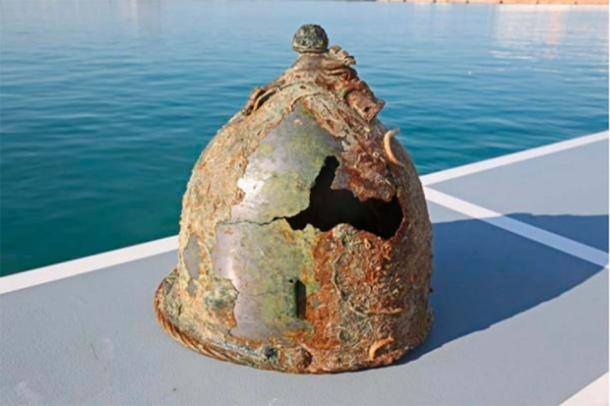
Roman helmet from the Battle of the Egadi Islands. (RPM Nautical Foundation)
They are the remnants of the Battle of the Egadi Islands - the last clash from the first Punic War which took place in 241 BC – in which the Romans fought the Carthaginians in a battle that culminated from more than 20 years of warring as the Romans struggled to gain a foothold in the Mediterranean Sea. While the Carthaginians were much more powerful on the water, the Romans lay in wait trapping the Carthaginians and blocking off their sea route in a sudden attack. Up to 50 Carthaginian ships were sunk, killing up to 10,000 men. The Roman victory set them on the road for Europe-wide domination. The priceless horde of artefacts had lain undisturbed on the seabed at a depth of 100 meters (328.08 ft) for more than two millennia.
2. 2,000-Year-Old Intact Roman Medicinal Pill Found In Submerged Shipping Vessel
In June, 2013, a team of Italian scientists conducted a chemical analysis on some ancient Roman medicinal pills discovered in the Relitto del Pozzino, a 2000-year-old submerged shipping vessel which sank off the coast of Tuscany, revealing what exactly the ancient Romans used as medicine.
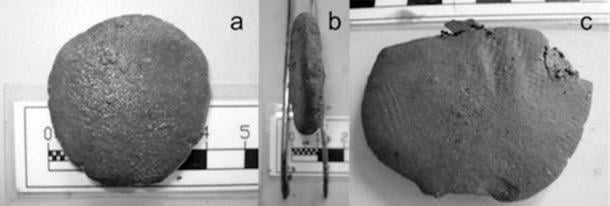
A front, profile, and rear view of one of the medicinal tablets. (PNAS/Giachi et. al.)
The Roman shipwreck lay near the remains of the Etruscan city of Populonia, which at the time the ship foundered was a key port along sea trade routes between the west and east across the Mediterranean Sea. The Relitto del Pozzino was excavated by the Archaeological Superintendence of Tuscany throughout the 1980s and 90s, revealing a variety of fascinating cargo including lamps originating in Asia minor, Syrian-Palestinian glass bowls, bronze jugs, ceramic vessels for carrying wine and, of particular interest, the remains of a medicine chest containing a surgery hook, a mortar, 136 wooden drug vials and several cylindrical tin vessels, one of which contained five circular medicinal tablets. The tin vessels had remained completely sealed, which kept the pills dry, providing an amazing opportunity to find out exactly what substances were contained within them. The results revealed that the pills contain a number of zinc compounds, as well as iron oxide, starch, beeswax, pine resin and other plant-derived materials. Based on their shape and composition, scientists have suggested that the tablets were used as a type of eye medicine.
3. Incredible Discovery Of Boat Wreck In Croatia Dated To 3,200 Years
In March 2014, marine archaeologist and researcher at the Centre National de la Recherche Scientifique (CNRS) in France, Giulia Boetto, announced the incredible discovery of a boat wreck in Zambratija Cove, Croatia, which was just dated to 1,200 BC. The unique and rare finding is a Bronze Age sewn boat, a type of wooden boat which is literally sewn together using ropes, roots, or willow branches.
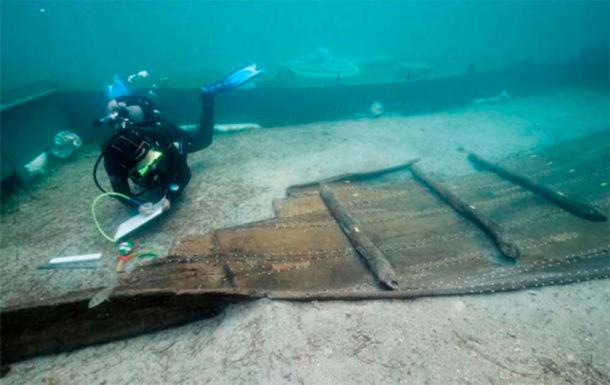
Wreck of Zambratija, Istria. Observations on the hull. (© Philippe Groscaux/Mission Adriboats/CNRS)
The boat measures 7 meters (22.96 ft) in length and 2.5 meters (8.20 ft) in width and is a sewn boat, which was a technique of shipbuilding practiced in the Adriatic until the Roman era. The remains of the boat found in Zambratija Cove are incredibly well-preserved for its age, with stitching still visible in some areas and the frame largely undamaged. The different types of wood used to construct it have been identified as elm, alder, and fir, and tree ring dating is currently underway, which will provide the date the tree was cut to the nearest year. Ms. Boetto said that they hope to finalize a 3D model of the boat and, eventually, a complete reconstruction.
4. Elongated Skulls Found In Maya Underwater Cave
In January, 2014, a flooded sinkhole in southern Mexico that terrifies local villagers was explored by underwater archaeologists, who found the submerged cavern littered with elongated skulls and human bones. The underwater cavern, known as Sac Uayum, is a cenote located in Mexico’s Yucatán Peninsula.
- Maya Canoe Found in Sinkhole Provides Clues to Belief in Underworld
- Maya City Sunk in Lake Atitlán Explored By Underwater Archaeologists
A cenote is a natural pit resulting from the collapse of limestone bedrock that exposes groundwater underneath. They were sometimes used by the ancient Maya for sacrificial offerings. Local legend says that the mysterious cavern is guarded by a feathered, horse-headed serpent. Older residents of the nearby village of Telchaquillo tell stories of people seeing the serpent perching in a tree, leaping up, spinning around three times, and diving into the water. From the first day of diving archaeologists discovered that there may be a very real reason why the villagers fear the place. It appears something terrible took place there and perhaps knowledge of this was passed down over the centuries leading to the development of myths and legends. The team identified more than a dozen human remains. The bones bear no marks that would indicate cause of death, so the people probably weren't sacrificed. According to the researchers, the elongated skulls were intentionally flattened during infancy, a practice that archaeologists are still seeking answers for.
5. Swedish Divers Find 11,000-Year-Old Underwater Relics
Swedish divers made a unique and rare discovery in the Baltic Sea – Stone Age artifacts left by Swedish nomads dating back 11,000 years. Researchers uncovered a number of remnants that are believed to have been discarded in the water by Swedes in the Stone Age, objects which have been preserved thanks to the lack of oxygen and the abundance of gyttja sediment, which is sediment rich in organic matter at the bottom of a eutrophic lake.
It is extremely rare to find evidence from the Stone Age so unspoiled. Buried 16 meters (52.49 ft) below the surface, the team uncovered wood, flint tools, animal horns and ropes. Among the most notable items found include a harpoon carving made from an animal bone, and the bones of an ancient animal called aurochs, the ancestor of domestic cattle, the last of which died off in the early 1600s. Archaeologists are continuing the dig, and are now particularly interested to see whether there is also an ancient burial site in the region.
6. Mysterious 10,000-Year-Old Underwater Ruins In Japan
On the southern coast of Yonaguni, Japan, lie submerged ruins estimated to be around 10,000 years old. The origin of the site is hotly debated - many experts argue that is man-made, while more other scientists insist it was carved out by natural phenomena.
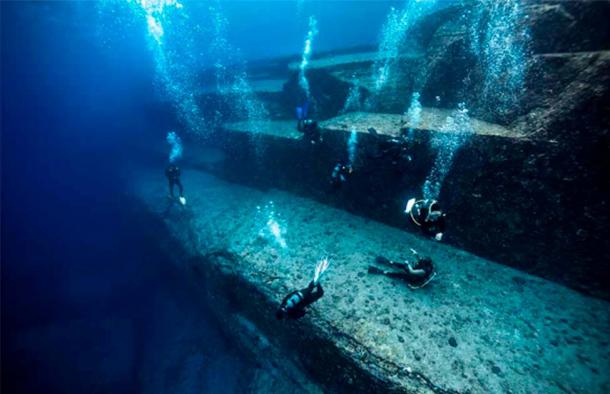
Yonaguni monument, Japan. (nudiblue /Adobe Stock)
The unique and awe-inspiring site was discovered in 1995 by a diver who strayed too far off the Okinawa shore and was dumb-struck when he stumbled upon the sunken arrangement of monolithic blocks "as if terraced into the side of a mountain". The site consists of huge stone blocks which fit together perfectly, right angled joins, carvings and what appear to be stairways, paved streets, crossroads and plazas. Despite the unusual features displayed at Yonaguni, there remains some scientists, such as Geologist Robert Schoch of Boston University, who have studied the formation and who are adamant that the large blocks formed naturally as a result of tectonic movement.
7. The Controversial Underwater Structures Of Zakynthos
In June 2013, Greek archaeologists announced an amazing finding – an ancient underwater city in the gulf of Alykanas in Zakynthos, Greece. According to the Underwater Antiquities Department, the discovery included huge public buildings, cobblestone paving, bases for pillars and other antiquities. Of particular significance were the 20 stone pillar bases, all of which feature a “34 cm diameter incision”, which were probably meant for wooden columns. Preliminary observations led to the conclusion that the remains belonged to a large ancient public building, probably belonging to an important settlement in the ancient city’s port. However, in a strange twist, a study released in December claimed that the ‘artifacts’ are not remnants of an ancient city at all, but simply a unique natural phenomenon.
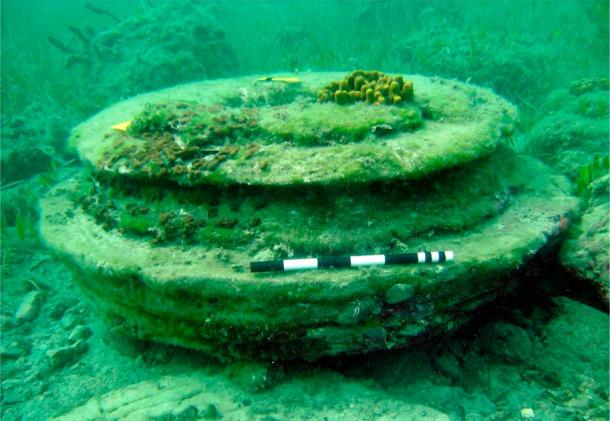
Disc and doughnut-shaped structures appeared to be architectural remnants of a city, but scientific analysis showed the formations to actually be a naturally occurring geological phenomenon. (University of Athens)
8. The Perfectly Preserved Ancient Chinese Underwater City
The Lion City, otherwise known as Shi Cheng, is an ancient submerged city that lies at the foot of Wu Shi Mountain (Five Lion Mountain), located beneath the spectacular Qiandao Lake (Thousand Island Lake) in China. Officials have taken a renewed interest in the sunken city since discovering it in February 2014, that despite more than 50 years underwater, the entire city has been preserved completely intact, transforming it into a virtual time capsule.
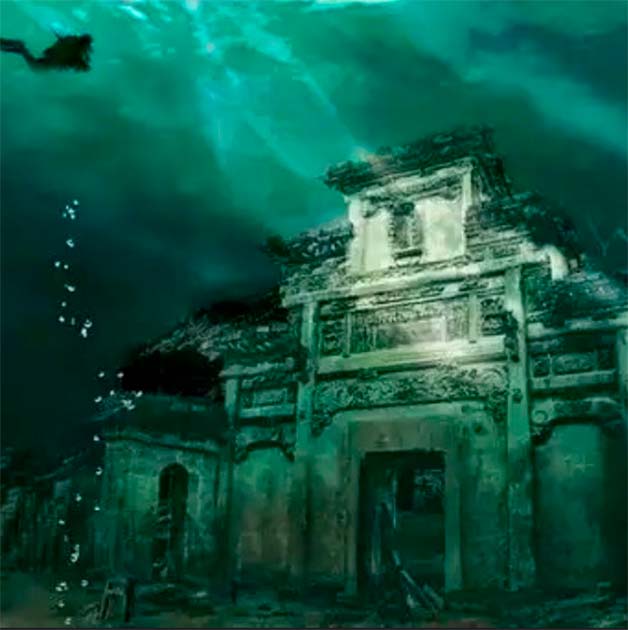
The Lion city in China, similar to the lost city of Atlantis. (ShashiBellamkon/flickr)
The Lion City was built during the Eastern Han Dynasty (25 – 200 AD) and was once the center of politics and economics in the eastern province of Zhejiang. But in 1959, the Chinese government decided a new hydroelectric power station was required - so it built a man-made lake, submerging Shi Cheng under 40 meters (131.23 ft) of water. The Lion City lay undisturbed and forgotten for 53 years, until Qiu Feng, a local official in charge of tourism, decided to see what remained of the city under the deep waters. He was amazed to discover that, protected from wind, rain, and sun, the entire city complete with temples, memorial arches, paved roads, and houses, was completely intact, including wooden beams and stairs.
9. The 5,000-Year-Old Sunken City In Southern Greece
In the Peloponnesus region of southern Greece there is a small village called Pavlopetri, where a nearby ancient city dating back 5,000 years resides. However, this is not an ordinary archaeological site, the city can be found about 4 meters (3.12 ft) underwater and is believed to be the oldest known submerged city in the world. The city is incredibly well designed with roads, two story houses with gardens, temples, a cemetery, and a complex water management system including channels and water pipes.
In the center of the city, was a square or plaza measuring about 40x20 meters ( 131.23 x 65.61 ft) and most of the buildings have been found with up to 12 rooms inside. The design of this city surpasses the design of many cities today. The city is so old that it existed in the period that the famed ancient Greek epic poem ‘Iliad’ was set in. Research in 2009 revealed that the site extends for about 9 acres and evidence shows that it had been inhabited prior to 2800 BC. Scientists estimate that the city was sunk in around 1000 BC due to earthquakes that shifted the land. However, despite this and even after 5,000 years, the arrangement of the city is still clearly visible and at least 15 buildings have been found. The city’s arrangement is so clear that the head of the archaeological team, John Henderson of the University of Nottingham, and his team, have been able to create what they believe is an extremely accurate 3D reconstruction of the city.
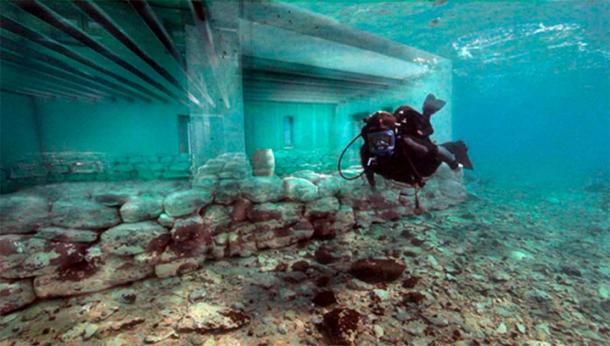
The underwater remains and the digitally reconstructed pillars and walls of one of the buildings. (Pavlopetri Underwater Archaeology Project)
10. Ancient Egyptian city of Heracleion - on the border between myth and reality
The city of Heracleion, home of the temple where Cleopatra was inaugurated, plunged into the Mediterranean Sea off the coast of Egypt nearly 1,200 years ago. It was one of the most important trade centers in the region before it sank more than a millennium ago. For centuries, the city was believed to be a myth, much like the city of Atlantis is viewed today. But in 2001, an underwater archaeologist searching for French warships stumbled across the sunken city. After removing layers of sand and mud, divers uncovered the extraordinarily well preserved city with many of its treasures still intact including, the main temple of Amun-Gerb, giant statues of pharaohs, hundreds of smaller statues of gods and goddesses, a sphinx, 64 ancient ships, 700 anchors, stone blocks with both Greek and Ancient Egyptian inscriptions, dozens of sarcophagi, gold coins and weights made from bronze and stone.
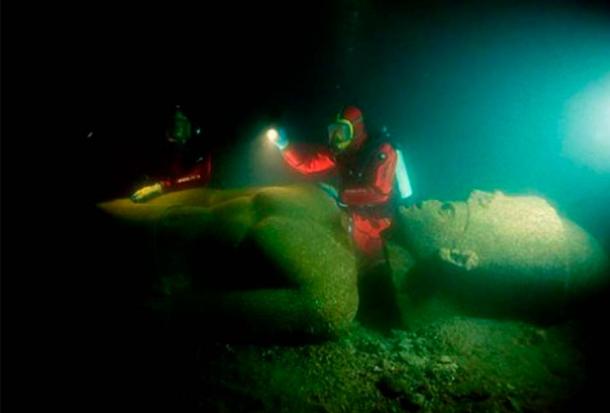
The team discovered a sunken statue of a pharaoh on the Mediterranean sea floor near the great temple of ancient Heracleion. (Christoph Gerigk © Franck Goddio/Hilti Foundation)
The Greek historian Herodotus (5th century BC) told us of a great temple that was built where the famous hero Heracles first set foot on to Egypt, and was named after him. He also reported of Helen of Troy’s visit to Heracleion with her lover Paris before the Trojan War. More than four centuries after Herodotus’ visit to Egypt, the geographer Strabo observed that the city of Heracleion, which possessed the temple of Herakles, is located straight to the east of Canopus at the mouth of the Canopic branch of the River Nile. However, until its discovery, Heracleion was just a place of legends.
Top image: Divers studying various underwater discoveries. Source: nudiblue /Adobe Stock / ShashiBellamkon/flickr / University of Athens
















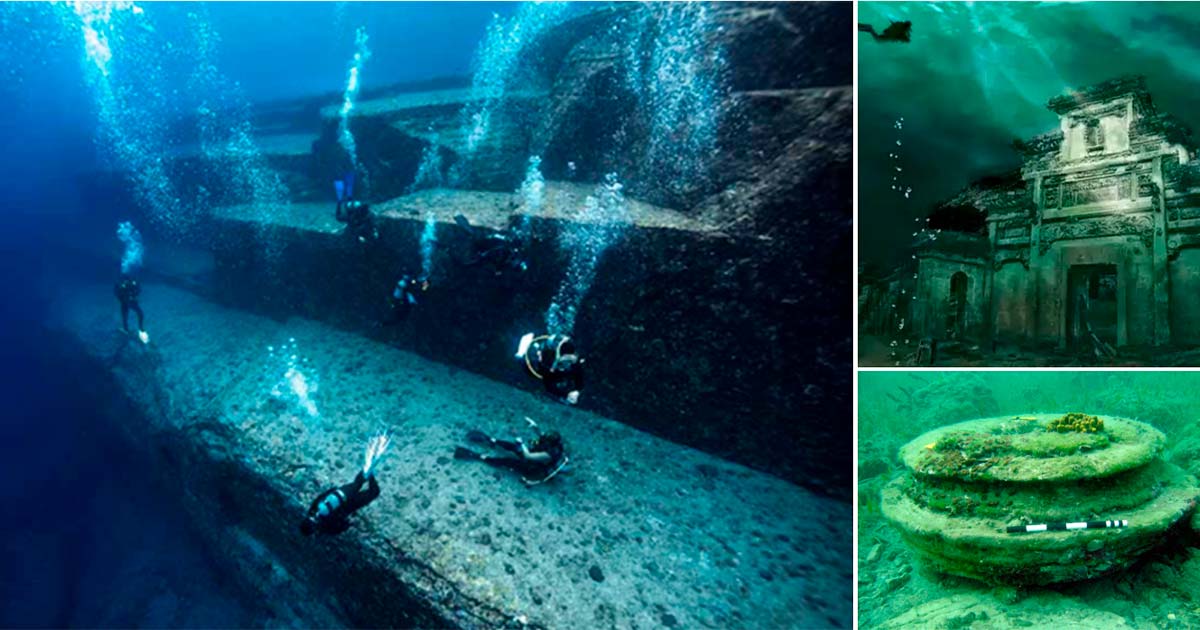

Comments
It is important to remember that Ice Ages have caused long term variations in sea levels. Couple that with the fact that people have long like building villages to cities along coasts, especially where a fresh water stream flowed into an ocean or sea, and we can see that there is much we have yet to learn. From what I understand, at one time, well within the times that people built towns and cities, the ocean was as much as 200 meters or more, lower than it is now. Combine that with earthquakes and volcanic events, and our ignorance of the past becomes quite obvious. A major volcanic event can make soil infertile for more than one hundred years. In the Mediterranean basin alone, there are many questions to be asked. The origin of the various sea peoples in the Levant, possible Etrusca, (sp?), as well as the question of what happened to the writers of Linear A in Crete, are just a few. Was the Mediterranean ever a fresh water sea, as the Black Sea once was. Legitimate questions about the Americas and South East Eurasia can also be asked. I have read about 'sunken cities' off the Indian coast. Even the Red Sea poses questions. I can only hope that the current and coming generations of archaeologists and historians can proceed with open minds. I know of sites that I have not revealed because of the dangers of inadequate funding for scholars, the potential for looting, and the intrusion of religious and political ideologies into what ought to be the realm of scholarship. I recent found out that an ancient wall I discover on the Malay Peninsula has been found again. I can only hope that it, and any artifacts discovered there will not end up on the black market. This continual state of war we find ourselves in ought to warn scholars of the dangers of excavations in regions where the sites can easily be seriously compromised or damaged by those deranged by what they claim is religion. All of us need to carefully think things through before we rush to expose what others wish to destroy.
Wasnt this a practice performed by ancient Peruvian people, applying pressure to the cranium of an infant, possibly one of a high status? I knew the Mayans utilized Cenotes in their religious rites involving human sacrifice, but wasn't aware of them elongating their people’s skulls!
I wonder if these victims were captives from a battle.
Cenotes are fascinating to explore – and beautiful, with clear water!
The Hockeycowboy